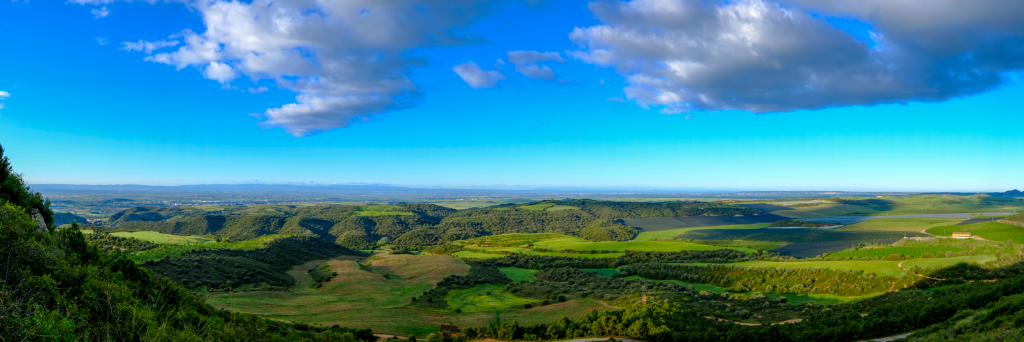The northern sector of this protected natural area is formed of a series of hills or small mountain ranges, which are part of the Barbastro-Balaguer-Almenara anticline and separate the Pre-Pyrenees from the Central Depression.
The lithology of this sector includes quaternary calcareous deposits, even though there is a predominance in the Serra Llarga of clayey-marl and gypsum outcrops from the so-called Barbastro gypsum. The southern part, on the other hand, is characterized by the agricultural plains of Balaguer, where sedimentary gravel and quaternary sand are prevalent.
The municipalities shaping the natural space include: Algerri, Castelló de Farfanya, Balaguer, Os de Balaguer, Ivars de Noguera, Camarasa, Menàrguens, Les Avellanes i Santa Linya.
FLORA AND VEGETATION
The northern part of the space is an excellent representative sample of the continental Mediterranean gypseous communities of the Ebro depression. The continental Mediterranean climate, which has arid tendencies, and the gypsum substratum are the main determining factors of the plant population of this area.
The vegetation is typical and specific to these gypsum soils, with calcicolous scrubs and gypsicolous thyme scrubland of Gypsophilion: Gypsophila struthium and Ononidetum tridentatae thyme scrubland, Lepidietum subulati and Ononidetum tridentatae thyme scrubland as well as Helianthemetum squamati and Ononidetum tridentatae thyme scrubland.
Together with the Llobregós Valley it hosts the best sample of gypsicolous plants in Catalonia. The higher and lower flora, which constitute these plant communities, are extraordinarily unique, with a great number of Iberian Mediterranean examples as well as some very rare and endemic species.
Under these special conditions of potential vegetation, the continental holm oak grove (Querceium rotundifoliae) is strictly limited to small residual fragments. The landscape is remarkable due to its mosaic of scrub, thyme scrubland and dry meadows together with areas of dryland crops.
Among the relevant taxa of flora there are Gypsophyla hispanica, Helianthemum squamatum, Reseda stricta, Lepidium subulatum, Ononis tridentata, Euphorbia helioscopia subssp. helioscopiodes, Limonium catalaunicum and Limonium ibericum, Valerianella multidentata and Senecio auricula subsp. sicoricus the last five are endemisms of the Ebro Valley.
The southern sector, on the other hand, is characterized by the dominance of cereal crops with very little natural vegetation, this being restricted to the margins of the fields as well as to the Farfanya river. Small scatterings of silver poplar groves (Vinco-Populetum albae) accompanied by ash trees grow along the river.
Species that are strictly protected by the PEIN
Gypsophila hispanica,Helianthemum squamatum,Lepidium subulatum,Ononis tridentata,Reseda stricta
WILDLIFE
The wildlife inhabiting the area is mainly sub-steppe in character, like the little bustard (Tetrax tetrax), the stone-curlew (Burhinus oedicnemus) or the European roller (Coracias garrulus) for example.
However, special mention should be made of the black-bellied sandgrouse (Pterocles orientalis), which can be found in the Balaguer drylands in its highest numbers within Catalonia and only reappears in some places such as la Granja d'Escarp, although the largest population can be found in the area of Monegros (Aragon).
As a result of a plan to recuperate the species carried out by the DMAH the lesser kestrel can now be found in the area. The calandra lark (Melanocorypha calandra) and the quail (Coturnix coturnix) exist in these drylands in one of the largest populations in Catalonia.
Other interesting species from a bird watching point of view include the tawny pipit (Anthus campestris) and the black wheatear (Oenanthe leucura). Within the field of herpetology, it is also remarkable to encounter the spiny-footed lizard (Acanthodactylus erythrurus) in this space.
The presence of the wild cat (Felis sylvestris) should be highlighted, given that this is the only area in Catalonia where this species occupies a habitat of these characteristics.
As regards invertebrate fauna, we must distinguish the lepidoptera for the following reasons: they are of great interest; this natural space hosts an enormous diversity of them; the population here includes some very rare African species (Zegris eupheme, Euchloe tagis, Albarracina warrionis).
Species that are strictly protected by the PEIN
Albarracina marrionis,Euchloe tagis,Zegris eupheme.
Wildlife species from Annex II of Directive 92/43, on habitats
A list referring to the grouping of areas forming part of the Natura 2000 network of Noguera Drylands.
In the case of the Serra Llarga-Noguera Drylands ENP (Natural Space of Ponent), the species include:
Lutra lutra, Rhinolophus euryale, Rhinolophus hipposideros.
Bird species from Annex II of Directive 2009/147, on birds
A list referring to the grouping of areas forming part of the Natura 2000 network of Noguera Drylands.
In the case of the Serra Llarga-Noguera Drylands ENP (Natural Space of Ponent), the species include: Ciconia ciconia, Milvus migrans, Milvus milvus, Circaetus gallicus, Circus aeruginosus, Circus cyaneus, Circus pygargus, Hieraaetus fasciatus, Falco naumanni, Falco peregrinus, Tetrax tetrax, Coracias garrulus, Melanocorypha calandra, Calandrella brachydactyla, Galerida theklae, Lullula arborea, Oenanthe leucura, Sylvia undata, Pyrrhocorax pyrrhocorax, Emberiza hortulana, Pterocles orientalis.
